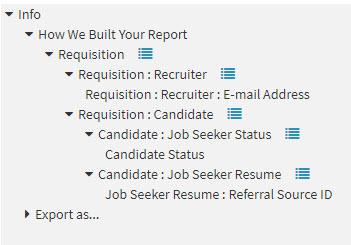Learn By Creating a Sample Report
Experiment with creating reports using the Data Explorer via a sample report.
To create a sample report:
- On the Navigation Pane, click Explore My Data.
- On the Data Explorer screen, click Suggested Favorites to expand options.
- Click Recruiting.
- Click Requisition.
- Click Fields in "Requisition" to expand the list of available fields.
-
Click
Recruiter (User ).
The Requisition: Recruiter table loads in the Your Data pane.
-
Click
E-mail Address.
The Field Actions area displays the Column Title field and a link to add the field to the report.
- Click Add this field to my report.
- Return to the Your Data pane and click Suggested Favorites » Recruiting » Candidate.
- In the Fields list, clickJob Seeker Status.
-
Click
Name (Token).
The Field Actions area displays the Column Title field and a link to add the field to the report.
- In the Column Title field, type Candidate Status to change the name.
- Click Add this field to my report.
- In the Search field, type "resume referral".
- Click Job Seeker Resume: Referral Source ID.
- Click Add this field to my report to add the field to your Cart, below the Report pane.
- In the Cart, click View Your Report.
-
In the Report pane, click the Info tree and expand
How We Built Your Report to examine the report structure determined by the Reporting Tool.
I
 Things to Learn From This Sample
Things to Learn From This Sample- The biggest takeaway is that Data Explorer can automatically help fill in missing information, without the need for you to spend time and energy planning.
- Requisition was deemed the most popular "root" item, so the Reporting Tool placed it at the top and it became the From portion of the report query.
- The Requisition object uses this chain to display the recruiter's email address.
- Regardless of how the Reporting Tool builds the report, User will remain linked to Requisition via the chain we built earlier.
- The column containing the candidate's status is in a chain that begins with Candidate.
- The data dictionary correctly identified a common relation between Requisition and Candidate and completes that chain by appending the column's chain to Requisition, which means this column's full chain is now Requisition » Candidate » Job Seeker Status.
- Our Referral Source column's chain begins with Job Seeker Resume.
- The Reporting Tool identifies a relation between Resume and Candidate and appends this column's chain, giving this new column a chain of Requisition » Candidate » Job Seeker Resume » Referral Source ID.
Parent Topic: Data Explorer